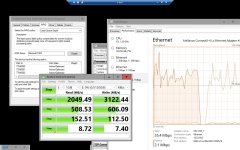I'm working on implementing an all NVMe san using dell a Dell R750 and 6 NVMe drives in a 2-to-a vdev config, each drive pair sharing a processor. I chose a thin provisioned pool and have attached the target to a MPIO initiator using two separate connectx-4 25gbe nics, one directly connected to the R750, the other through a FS switch.
My thin provisioned pool was setup this evening--I've seen some file systems that require a "build" time, even with mirroring, perhaps this is what's going on??
My sequential 1M read/write speeds seem to be better than expected-- 2050MB/s read, 3100MB/s write, but I cannot seem to get the random single thread 4K read/writes past 8MB/s on both ends!
Is this a reflection on the limits of iscsi connections?? If so, my dreams of a SAN with three failover cluster hosts attached will have to go out the window. Please help!
My thin provisioned pool was setup this evening--I've seen some file systems that require a "build" time, even with mirroring, perhaps this is what's going on??
My sequential 1M read/write speeds seem to be better than expected-- 2050MB/s read, 3100MB/s write, but I cannot seem to get the random single thread 4K read/writes past 8MB/s on both ends!
Is this a reflection on the limits of iscsi connections?? If so, my dreams of a SAN with three failover cluster hosts attached will have to go out the window. Please help!

